2020 Survey
The Fifth Annual Idaho Public Policy Survey was conducted December 5-13, 2019, and surveyed 1,000 adults over the age of 18 who currently live in Idaho. The sample is designed to be representative of the population of the state both geographically and demographically. This was a mixed-mode survey which contacted respondents on land line phones (33%), cell phones (33%), online (30%), and via text message (5%). The goal of using multiple means to contact respondents is to increase our coverage of the population to people who may not respond to traditional phone surveys. This survey focused on important issues facing Idaho including growth, education, taxes, and the environment. The survey has a simple random sampling margin of error of +/- 3.1% and was conducted by GS Strategies Group.
Fifth Annual Idaho Public Policy Survey
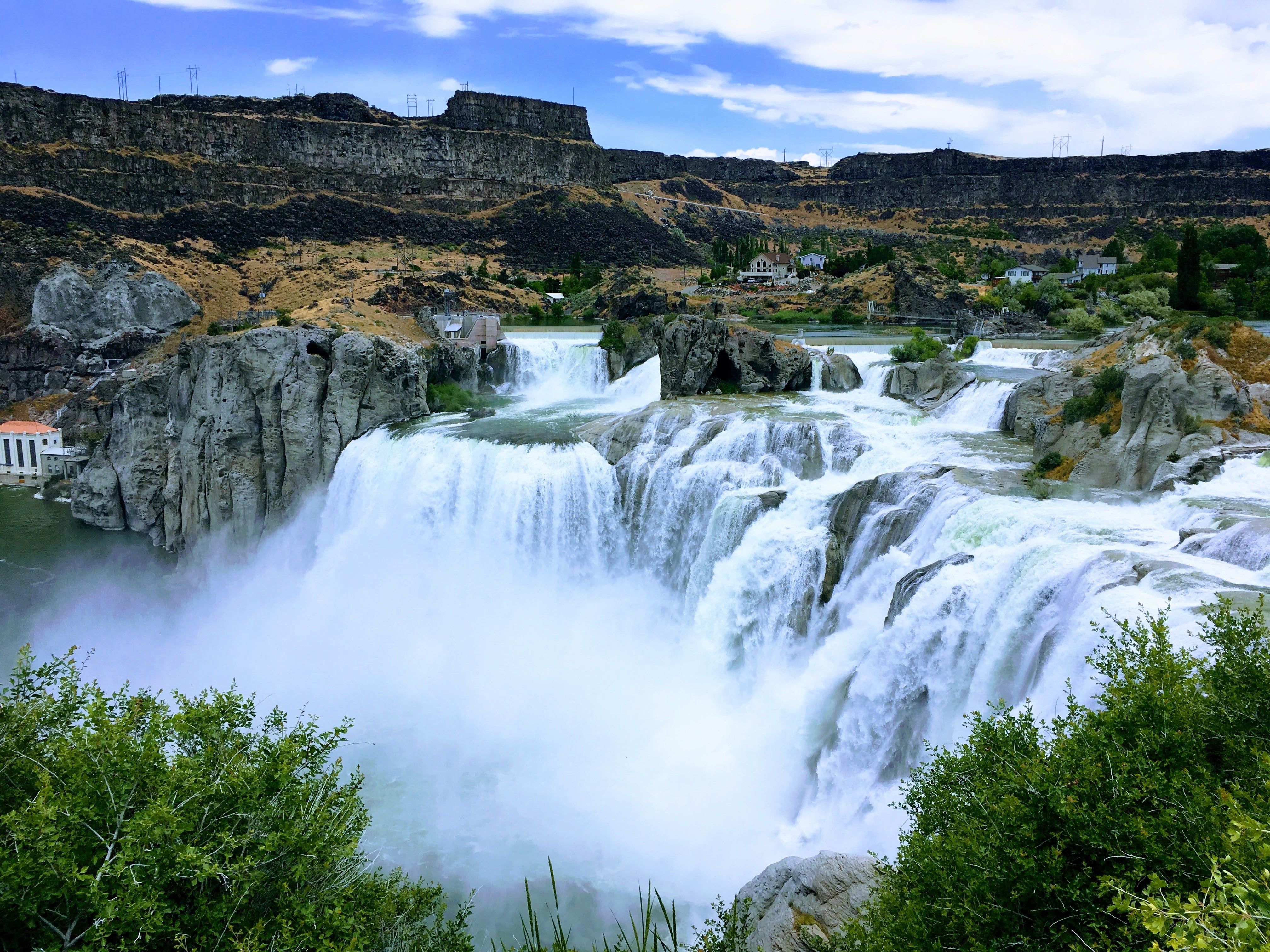 Report Author
Report Author
Jeffrey Lyons, Director of Survey Research, Idaho Policy Institute
About the Survey
The Fifth Annual Idaho Public Policy Survey was conducted December 5-13, 2019, and surveyed 1,000 adults over the age of 18 who currently live in Idaho. The sample is designed to be representative of the population of the state both geographically and demographically. This was a mixed-mode survey which contacted respondents on land line phones (33%), cell phones (33%), online (30%), and via text message (5%). The goal of using multiple means to contact respondents is to increase our coverage of the population to people who may not respond to traditional phone surveys. This survey focused on important issues facing Idaho including growth, education, taxes, and the environment. The survey has a simple random sampling margin of error of +/- 3.1% and was conducted by GS Strategies Group.
- Majorities of Idahoans have positive evaluations of the state. They remain optimistic about the direction that the state is headed (56%), feel that the level of taxation is about right (61%), and believe that the economy will either continue at its current pace or improve over the next two years (72%).
- Education continues to be seen as a weak spot in Idaho. Most perceive the quality of education in the state to be fair or poor (65%), and education tops the list of priorities for the state legislature.
- Growth was the most frequently named issue facing the state, and a majority (57%) believe that the state is growing too fast.
- Those who have moved to Idaho in the last 10 years are slightly younger and have slightly higher educational attainment than those who have been here for longer, but are very similar in their party affiliation.
- Idahoans are divided on whether dams on the lower Snake River should be removed to aid salmon recovery. Lost hydroelectric power is the most commonly cited reason for opposing dam removal.
- There is overwhelming support (86%) for banning texting while driving.
- A majority of Idahoans (63%) are satisfied with the current rules for getting an initiative on the ballot for a citizen vote.
For more information, visit: boisestate.edu/sps/2020-idaho-public-policy-survey/
To begin, we look at the general perception of people in Idaho about how things are going in the state. The first question we explore is whether people think that the state is headed in the right direction, or is on the wrong track. We find that a majority of Idahoans (56%) believe that the state is headed in the right direction, and a minority (30%) feel that the state is on the wrong track. These numbers are within the margin of error of those from last year, pointing to consistent opinions on the direction that the state is headed in. Unsurprisingly, Republicans are more positive about the direction that the state is going in; 67% of Republicans compared to 40% of Democrats believe that the state is on the right track.
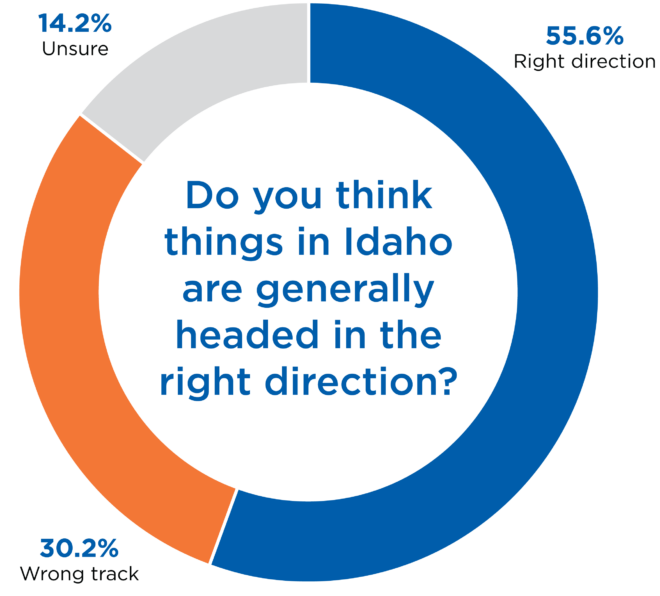
Often closely tied to attitudes about the direction that the state is headed in are perceptions about the economic future of the state. When asked if they thought that the Idaho economy was going to get better, worse, or stay about the same over the next two years, we find that people are generally positive. 37% of respondents expect the economy to get better, and 35% expect it to stay the same. Only 21% of Idahoans expect things to get worse. In general, Republicans are more optimistic than Democrats about the future of the Idaho’s economy – 45% of Republicans believe that the economy is going to get better over the next two years compared to 29% of Democrats. The levels of optimism we see are generally similar to last year, though there was a small decrease in the number who felt that the economy was going to stay the same.
While optimism appears to be high in the state, we consider the type of issues people see as being the most pressing. We asked people an open-ended question on their opinion of the most important issue facing the state. We then code these responses by grouping them into similar themes and ideas. When we do this, we find that issues related to growth topped the list of the most important issues facing the state. 19% of respondents gave a response that was related to growth, though the details of these comments ranged from limiting population growth to too many outsiders moving to Idaho. This is the first year that growth concerns appeared at the top of the list, though they were the fourth most common response last year (9% of Idahoans identified it as the top issue). Aside from the shift at the top of the list, responses were relatively similar to prior years. The second most frequently mentioned issue was education (16%), which was the top concern last year when 25% cited it as the most important issue. The remainder of the top five most important issues were the economy (7%), affordable housing (6%), and heath care (5%).
There are some partisan differences that emerge in the top concerns. A higher percentage of Republicans than Democrats identified growth-related issues as the most important – 23% of Republicans, 19% of Independents, and 12% of Democrats saw growth as the primary issue. Alternatively, Democrats were more likely than Republicans to identify education as the most important issue, with 20% of Democrats, 18% of Independents, and 15% of Republicans identifying this issue.
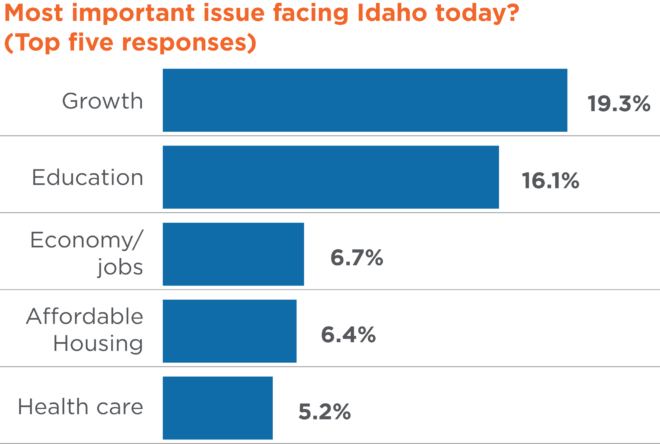
While these were the issues that people in the state saw as the most important, we also considered which issues should be the state legislature’s top priorities. For this question, respondents were asked to rank each issue presented on a scale from 1-10, with 1 defined as not at all important for the state legislature to address the issue, and 10 that it is extremely important for the legislature to address it. We analyze this data by looking at the percentage of respondents who gave a rating from 8-10, suggesting that they think it is very important for the legislature to address the issue.
When we rank the issues by the percentage who give an 8-10 rating, we see that education emerges as the top issue Idahoans believe that the legislature should address with a sizeable majority of people (75%) giving an 8-10 rating. All partisan groups assign a very high importance to education, with 86% of Democrats, 77% of Independents, and 71% of Republicans giving the issue an 8-10 rating. Rounding out the top five issues for the percent who give an 8-10 rating are jobs and the economy (64%), healthcare (61%), housing (53%), and natural resources (52%). Receiving a lower prioritization from people are the environment (51%), taxes (47%), immigration (41%), and transportation (39%).
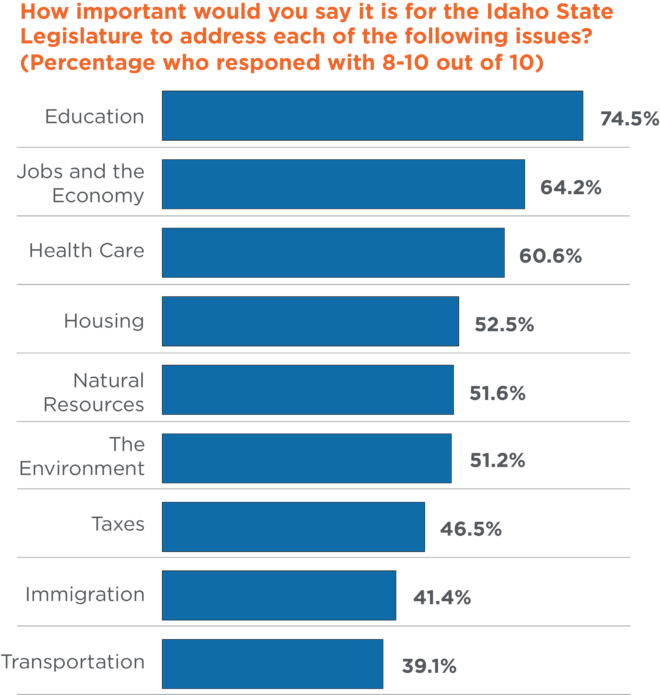
The order of this list is similar to last year where education was identified as the most important issue followed by jobs and the economy, healthcare, natural resources, and the environment. This was the first year that housing was included as a possible issue which is why it does not appear on previous rankings.
Given the current importance of growth in Idaho, we turn to perceptions about how fast the state is growing. For the first time on the statewide survey, we ask people whether they think that growth in Idaho is occurring too fast, too slow, or about right. A majority of Idahoans (57%) responded that the state was growing too fast, and a sizeable number (35%) said that the pace of growth was about right. Very few people (5%) said that Idaho was growing too slow. There are some partisan differences in perceptions of the pace of growth, Republicans (63%) and Independents (60%) are more likely to see the pace of growth as too fast than Democrats are (46%). While we do not have prior years of data on this question to compare to, this question has been asked on the School of Public Service’s Treasure Valley Survey which surveys only Ada, Canyon, Gem, Owyhee, and Boise counties. In 2019 we found that 75% of people in the Treasure Valley believed that growth was occurring too fast.
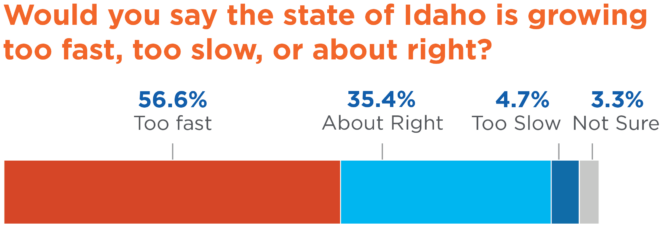
With the growing population in Idaho, questions emerge about who the new residents are, and how they may change our state. To explore this, we look to a series of questions about whether the person has lived in Idaho all of their life, and if not, how long they have been here and what state they came from. By identifying who the new residents of Idaho are, we can compare them to those who have been here for a long time to identify any similarities or differences between the groups. First, we can look at the states of origin for the movers in our sample. We see that the most common state of origin is California, comprising 26% of those who have moved to Idaho. The remainder of the top-five are all states that border Idaho – Washington (14%), Utah (10%), Oregon (8%), and Nevada (5%).
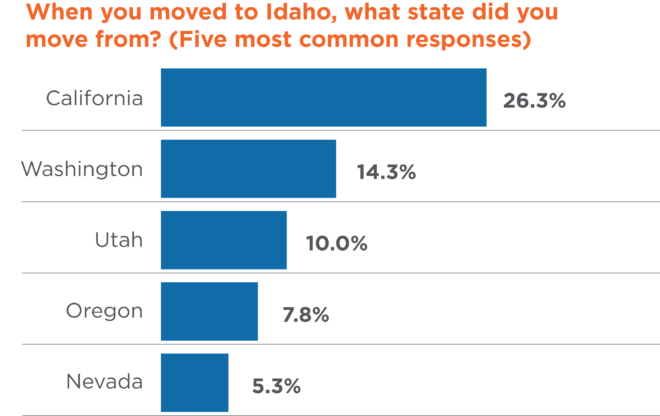
For the analysis that follows, we compare those that have moved to Idaho in the last 10 years to those who have been here for longer (including both those who have lived in Idaho for their whole lives as well as those who moved here 11+ years ago). Doing this allows us to speak to the group composition of recent arrivals, as they may have different characteristics compared to those who moved to Idaho decades ago.
Looking first to age, we compare the average age of those who have moved here in the last 10 years to the average age of those who have been here for 11 or more years. We find that recent arrivals are slightly younger with an average age in the 35-39 group, while those who have been here for longer have an average age in the 40-44 range.
Turning to education, the group that has moved here in the last 10 years has slightly higher educational attainment than the group who has been here for 11 or more years, though the differences are not dramatic. Only 12% of recent movers have a high school education or less, while 24% of those who have been in Idaho for longer have a high school education or less. On the other side of the coin, 46% of those who have moved to Idaho in the last 10 years have at least a Bachelor’s degree, compared to 37% of those who have been here for longer.
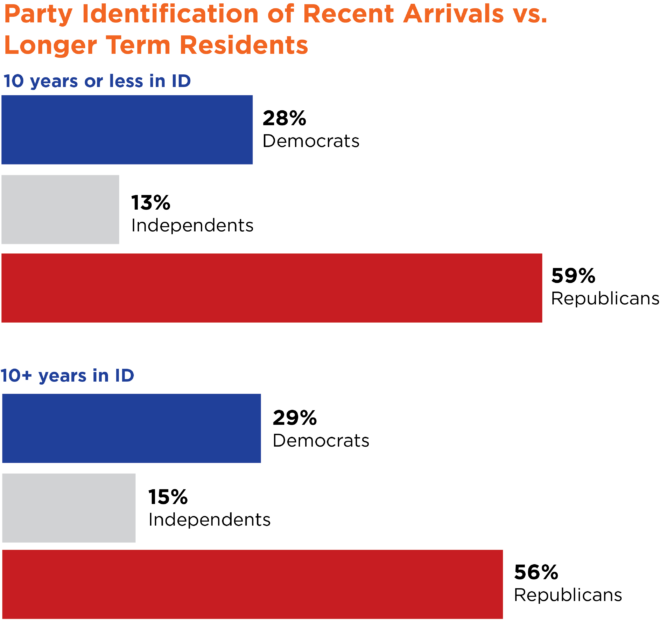
Finally, when we look to political attitudes, we see that those who have moved to Idaho in the last 10 years have a similar orientation to those who have lived here for longer. For those who have lived here for longer than 10 years, we see that 29% identify as Democrats, 15% as Independents, and 56% as Republicans. Looking to those who have moved here from out of state, 28% identify as Democrats, 13% as Independents, and 59% as Republicans. Put differently, the partisanship of the group that has moved here in the last 10 years is essentially the same as the partisanship of the group that has been here for longer.
While those who have moved here in the last 10 years may not be different than those who have been here for longer, what about the group that is largest share of movers and has received the most attention – Californians? We can look at Californians in two different ways. One is to look at those who moved to Idaho from California at any point in time, the other is to look at the Californians who have moved here in the last 10 years.
Turning first to the people who have moved to Idaho from California at any point in time, they are a decidedly Republican group. Only 22% of the Californians who have moved to Idaho identify as Democrats, 13% as Independents, and 65% as Republicans. The picture is quite similar for the Californians who have moved to Idaho in the last 10 years. For this group, 14% identify as Democrats, 17% as Independents, and 70% as Republicans. A note of caution is warranted when it comes to interpreting these results as we are dealing with relatively small numbers of people when we parse the data down on all of these criteria. For the results that were just discussed, there are 152 people who have moved from California at any time, and 59 who have moved from California in the last 10 years.
Identified as the second most important issue facing the state and the top priority for the legislature to address is the issue of education. We asked two questions about Idahoans’ perceptions of the quality of K-12 education in the state. First, we asked how they would rate the quality of K-12 education in the state of Idaho as a whole. We see that perceptions of quality for the state are not especially positive. The most common response was that quality is fair (35%), followed by poor (30%). On the other side of the coin, only 4% see the quality of education as excellent, and 25% see it as good. If we simplify our view, 65% see K-12 quality as fair or poor, and 29% see it as good or excellent. These numbers are very similar to those that we have observed in past years, suggesting that these are relatively stable perceptions.
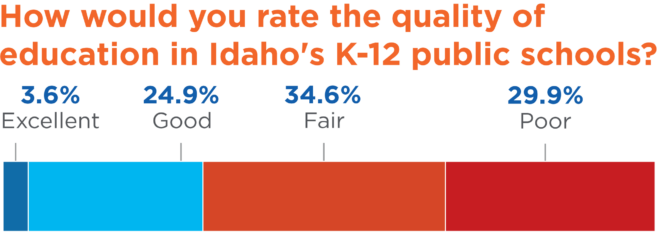
The picture for perceptions of quality is a little more positive when we ask people to consider their school district rather than the whole state. When focusing on one’s own district, 9% believe the quality of education is excellent and 33% believe that it is good, compared to 30% who think it is fair and 19% who responded that it is poor. If we group these responses, 41% see the quality in their district as either excellent or good, and 49% see it as fair or poor. Those who have children under the age of 18 are especially pessimistic about the quality of education in their school district – 28% of parents viewed it as poor, compared to 15% of those without children under 18.
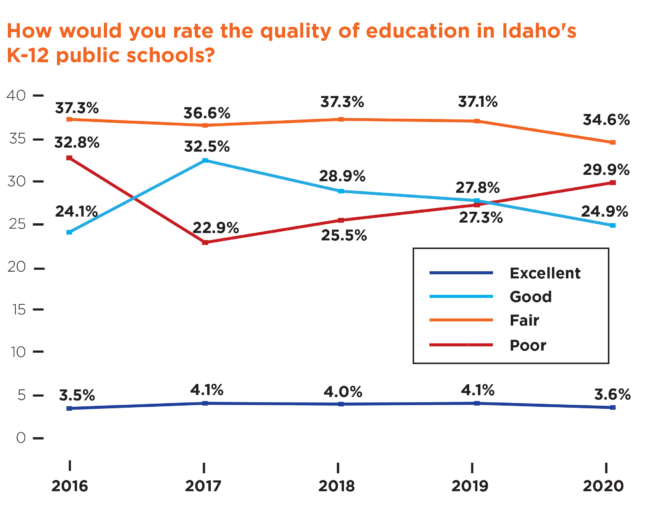
In addition to bolstering K-12 education, much discussion in Idaho has centered on increasing the number of Idaho students who further their education after high school. We sought to understand what people in Idaho think about the job that schools in Idaho are doing to prepare students to further their education beyond high school. As with the previous questions, we asked about this for both the state of Idaho as a whole, and about the schools in one’s own area. In general, the results mirror the perceptions of K-12 quality. Looking first to perceptions in the state of Idaho as a whole, a minority hold positive assessments – only 5% state that an excellent job is being done, and 25% said that a good job was being done. On the other hand, most Idahoans hold more pessimistic assessments with 39% saying that schools in Idaho are doing a fair job of preparing students to further their education beyond high school, and 23% say that they are doing a poor job.
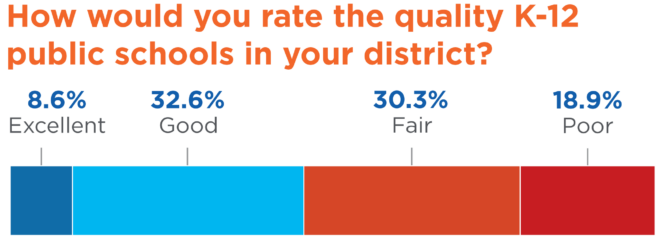
Perceptions become slightly more positive when focusing on the job that schools are doing in one’s own area. Here we see 8% reporting that schools are doing an excellent job, and 29% say that they are doing a good job. Most respondents have less positive assessments – 34% say that schools are doing a fair job and 21% report that they are doing a poor job.
To assess how Idahoans view the state’s fiscal picture, we begin with a general question about whether they think the state’s budget should be increased, decreased, or stay about the same. This is a question that is often used to gauge people’s attitudes about the size and scope of government. When presented with this question, the most common response given (43%) was that the state budget should be increased, with a sizeable number (32%) saying that it should stay about the same. There appears to be little inclination to decrease the state budget, as only 10% selected this option. 65% of Democrats favor increasing the state budget, compared to 44% of Independents and 32% of Republicans. Age is also a factor that results in different responses – 53% of those from 18-29 favor increasing the state budget compared to 34% of those over 65. There appears to be a slight rise in the number who believe that the state budget should be increased from last year when 37% thought that the budget should be increased.
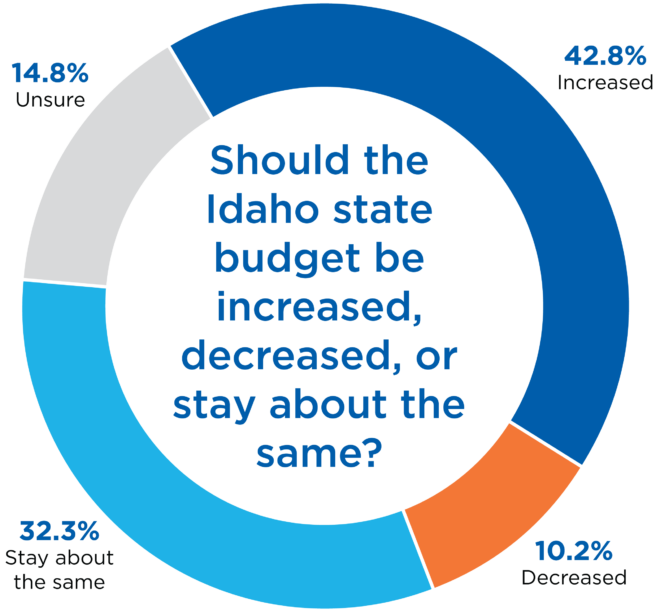
Turning to taxes, we asked whether people thought that taxes in the state are too high, too low, or about right. We find that a sizable majority express satisfaction with the level current level of taxation – 61% say that taxes are about right. While there are some partisan differences on this question, majorities of all partisan groups feel the current taxes are about right. 56% of Democrats, 60% of Independents, and 64% of Republicans viewed taxes as being about right. The next most common response is that taxes are too high, with 27% of Idahoans holding this opinion. Very few (8%) feel that taxes are too low. There was a slight increase in the number who said that taxes are too high compared to last year when 20% reported this view.
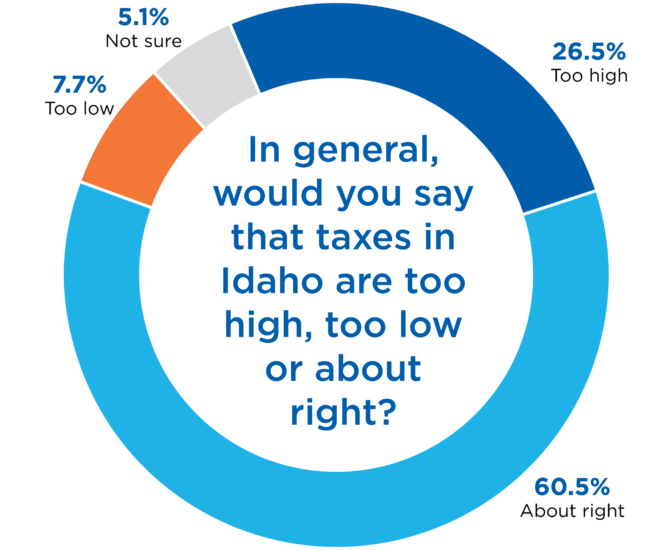
While most people in the state are satisfied with the rate of taxation, they don’t necessarily want the tax system to remain unchanged. To see what kind of appetite for change exists, we asked people about the magnitude of changes that they would like to see made to Idaho’s tax system. It is important to note that this question does not speak to tax rates – someone could respond that they want to see major changes to the tax system if they wish to have either dramatically higher or lower taxes. The most common response that was given (53%) is that some changes are needed, but that the system should stay basically the same. The next most common response (16%) was that the current system works fairly well as it is now. Taking these two responses together, 69% of people either think that the system should remain unchanged or changed a small amount. On the other hand, 14% responded that major changes are needed, and 8% that a complete overhaul of the system is needed. It is worth noting that Democrats were more likely than Republicans to believe that these large changes needed to be made – 29% of Democrats selected either major changes or a complete overhaul, compared to 15% of Republicans. On the whole, these responses are very similar to what we have seen in previous years, pointing to relatively stable beliefs about these matters.
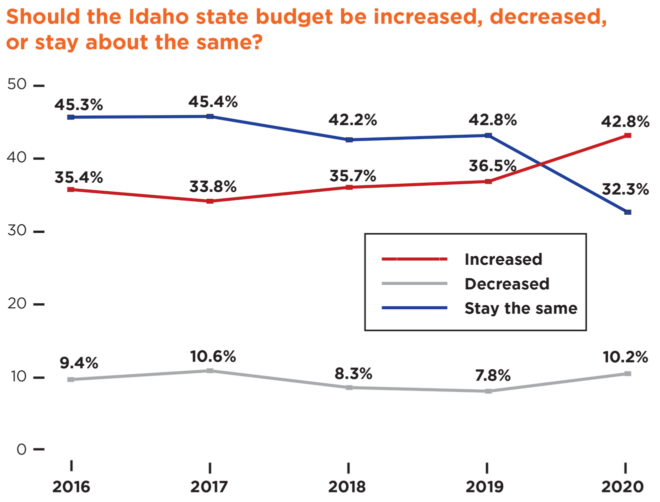
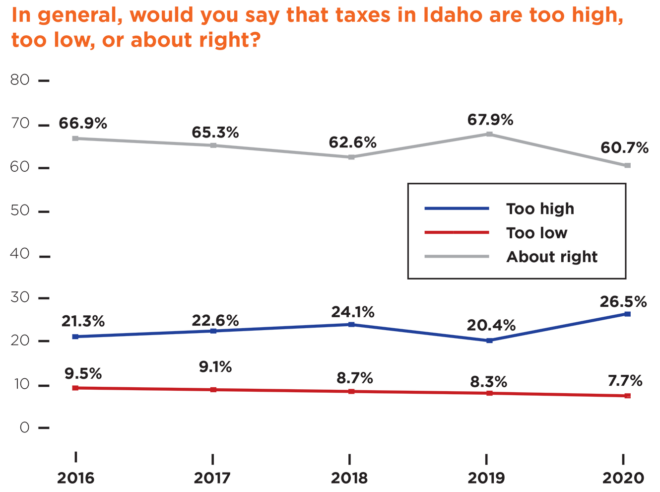
One possible change to Idaho’s tax system that has been discussed by many local jurisdictions would be the adoption of local option sales taxes. Idaho law currently prohibits most local governments in the state from holding a vote on whether to implement a local option sales tax or not. As a result, we have been asking whether people would favor or oppose giving every city in the state the ability to hold a vote on these matters. We find that a majority of Idahoans favor allowing cities to hold a vote on whether to implement a local option tax – 28% strongly favor allowing cities to hold a vote, and 33% somewhat favor it. Taken together, 61% of Idahoans report a favorable view on allowing cities to vote on local option taxes. Alternatively, 17% strongly oppose and 14% somewhat oppose allowing cities to vote on these taxes. When taken together, 31% are in opposition to holding a vote on these taxes. Majorities of Democrats (76%), Independents (63%), and Republicans (55%) are in favor of allowing citizens to vote on local option sales taxes. Further, these numbers are very similar to what we found last year.
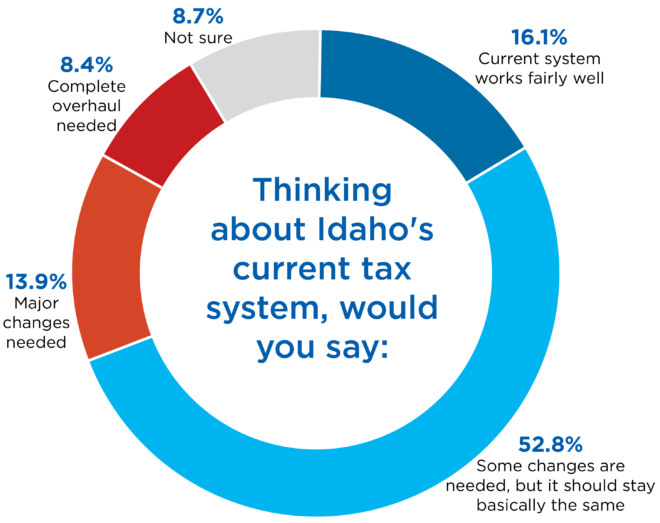
While a majority are in favor of cities and local jurisdictions being able to vote on these taxes, that does not mean that people would necessarily vote in favor of a local option sales tax increase in their town or city. While an actual measure could take a variety of different forms in terms of how high the sales tax is and what it goes to pay for, we explored whether people would support a tax to pay for transportation improvements. Because transportation improvements could take different forms we randomly split our sample of 1,000 into two groups of 500 people. We asked these two groups slightly different versions of the question. One group was asked whether they would support a local option sales tax to pay for improvements in public transportation, and the other group was asked whether they would support a local option tax to pay for road and bridge improvements. We find that majorities in both groups report that they would vote in favor of such a tax – 52% say that they would favor a local option tax to support public transportation improvements, and 57% would be in support for road and bridge improvements. 42% would oppose a local sales tax for public transportation and 36% would oppose it for roads and bridges. Although it appears that road and bridge improvements are more popular than improvements to public transportation, the differences between these two are within the sampling margin of error, so we cannot conclude that one kind of transportation improvement is more favored than another. What we can say with confidence is that more Idahoans report favoring a local option sales tax to support transportation improvements than report opposing them.
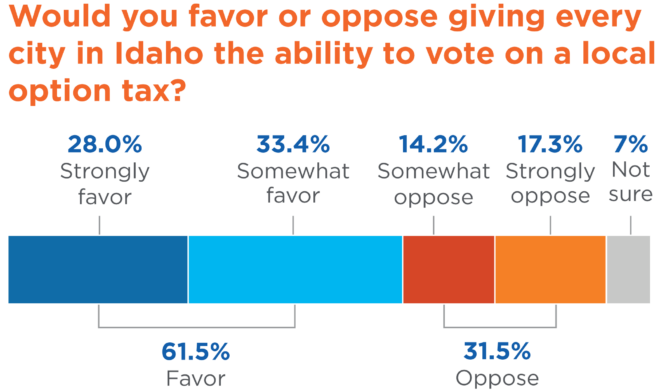
When we look how partisan groups say they vote, majorities of Democrats and Independents say that they would favor a local option sales tax to fund either road and bridge improvements or public transportation improvements, while a majority of Republicans would not support them.
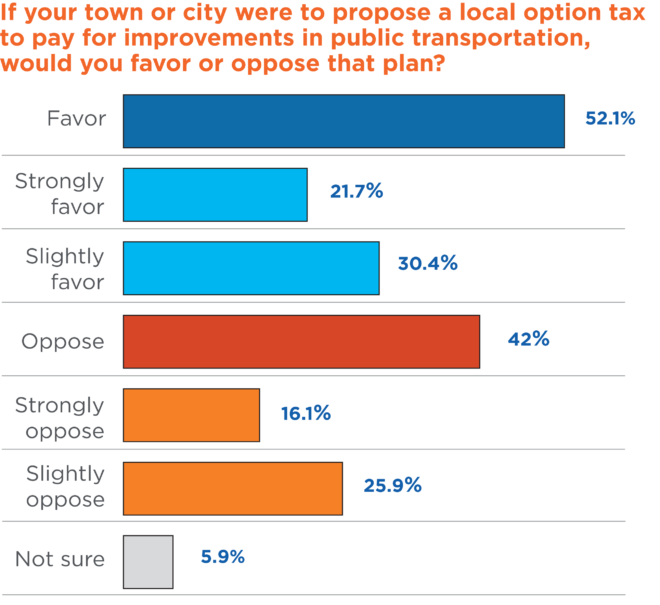
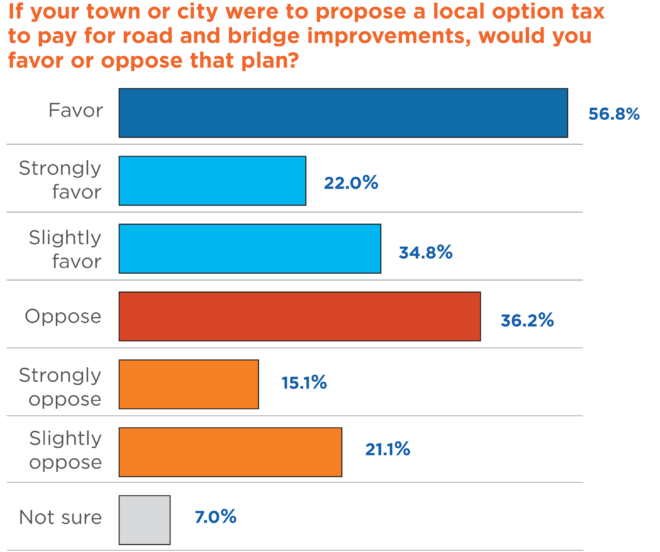
Election law is a frequent topic of conversation in state legislatures, and Idaho is no exception. Recently there have been discussions about the ease (or lack thereof) of getting initiatives on the ballot for a citizen vote. With this in mind, we asked Idahoans a question that sought to gauge their opinions on whether it should be easier or harder for an initiative to make it on the ballot. To do this, we presented people with the current rules which stipulate that 6% of the registered voters in 18 of the state’s districts need to sign a petition in order for an initiate to be placed on the ballot, and then asked whether they thought it should be easier, harder, or stay about the same.
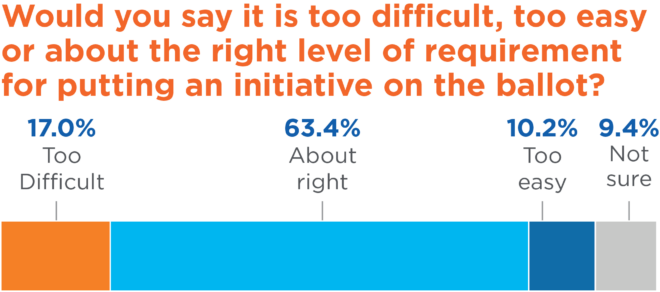
We find that a majority of Idahoans are satisfied with the current level of restrictiveness – 63% responded that the current requirements are about right. Among those who felt that the current rules could be changed, Idahoans were somewhat divided with 17% believing that it is too difficult to get a measure on the ballot, and 10% believing that it is too easy. The view that the current rules are about right is held by all partisan groups, with 62% of Democrats, 62% of Independents, and 68% of Republicans believing that the rules are about right. Democrats have the largest share who believe that it is too difficult to get a measure on the ballot, with 26% of Democrats reporting that view.
Another issue that is being discussed widely in Idaho is texting while driving. To explore what Idahoans think about this issue we asked two questions, one about whether people have texted or emailed while driving in the last three months, and another about whether they would support legislation to make it illegal to text or email while driving. Looking first at whether people report texting while driving, we find that a sizeable minority (39%) of Idahoans admit to doing this in the last three months, while a majority (60%) do not report texting while driving.
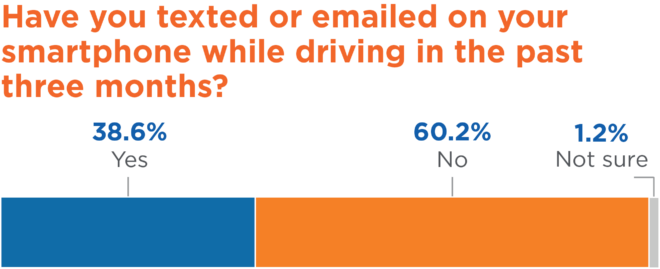
It warrants mentioning that people often underreport behaviors that could be viewed as socially undesirable, so the numbers here likely represent a minimum estimate of the frequency that this is occurring, and the actual prevalence could be higher. Young people are much more likely than older ones to report texting while driving – 57% of those from 18-29 stated that they have texted or emailed while driving in the last 3 months, compared to 2% of those over the age of 65.
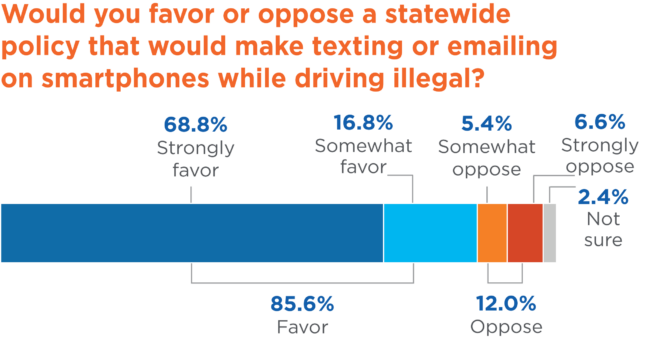
Looking to attitudes about banning texting while driving, we find overwhelming support for such a restriction. 86% of Idahoans favor making it illegal to text and drive, and 68% strongly favor such a rule. Only 12% stated that they oppose such a law. There is sizeable support amongst all partisan groups.
Turning to an environmental issue that has been receiving much attention in Idaho and throughout the northwest, we sought to understand what Idahoans think about the removal of the four federal dams on the lower Snake River in Washington to aid in salmon and steelhead recovery. When asked if they favor or oppose dam removal, Idahoans are split – 40% favor and 38% oppose. These are numbers are within the sampling margin of error, so we are not able to say that more people favor than oppose. Also of note, 22% of respondents said that they were not sure, which is a very high percentage compared to most of the questions that were asked on this survey. This suggests that whether people ultimately end up favoring or opposing dam removal will depend upon how the group who is currently not sure changes their views.
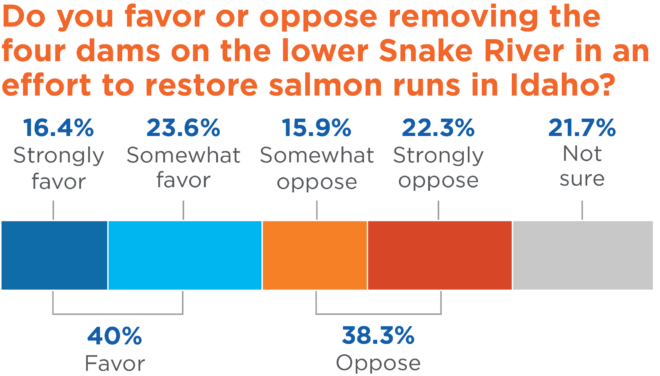
Not surprisingly, partisan differences emerge on this question. A majority of Democrats (59%) support dam removal, but a minority of Independents (38%), and Republicans (31%) are supportive. One of the primary drivers of selecting the not sure response is length of time living in Idaho. Almost one-third (32%) of those who have lived in Idaho for 10 years or less were not sure whether they favored or opposed dam removal, while 19% of those who have lived here for longer were not sure.
In an effort to better understand the concerns of those who oppose dam removal, those who responded that they opposed dam removal were asked a follow-up question which offered a number of possible reasons why they might oppose dam removal. The most commonly cited reason for opposing dam removal is the lost hydroelectric power that would result, with 35% of those who oppose removal selecting this option. Other frequently stated reasons for opposing removal were lost irrigation/water (16%), not believing that dam removal would recover salmon (14%), it would harm local communities (13%), and that it would be too expensive (8%).
There were not any especially notable patterns across partisan groups, but Republicans were more skeptical than Democrats that dam removals would work to recover salmon populations (15% of Republicans vs. 6% of Democrats).
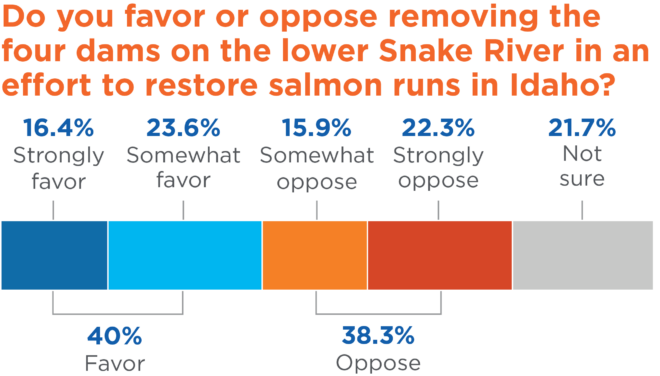
Pivoting from Idahoans’ opinions on policy matters, we look to their charitable donation habits, something of interest to those in non-governmental sectors who are involved in the policy process. First, we wanted to understand what kinds of causes are people in Idaho are most likely to give to. People were given the options of local, national, and international causes, as well as the option that they do not make charitable donations. We find that Idahoans are most likely to donate to local causes, with 77% who selected that option. Far fewer indicated that they were most likely to donate to national (11%) or international (5%) causes. Very few (5%) indicate that they do not make charitable donations, though there may be a social desirability effect where people do not want to say that they abstain from making charitable donations.
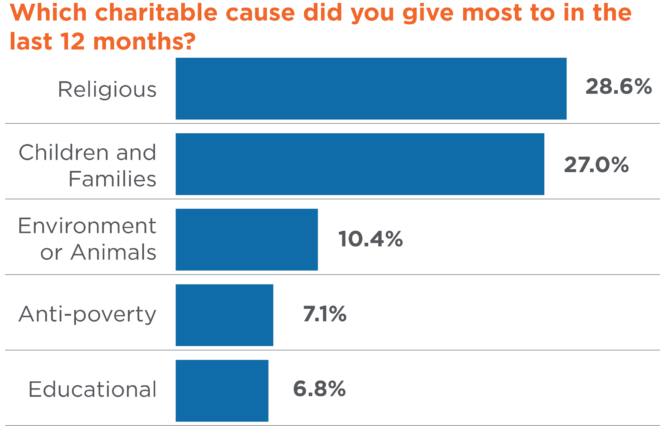
Those who indicated that they do make charitable donations were asked which kinds of causes they give the most to. We find that the causes people in Idaho were most likely to give to are religious ones (29%) and those pertaining to children/families (27%). Rounding out the top five causes are the environment/animals (10%), anti-poverty (7%), and educational (7%).
Finally, we ask about perceptions of how generous our fellow Idahoans are. We find that people are essentially split between the belief that Idahoans are about as generous as people in other states (38%) and more generous (35%). Relatively few (12%) believe that people in Idaho are less generous than those in other states, though a fair number are not sure (15%).
Idahoans report a generally upbeat view of the state – majorities think the state is headed in the right direction, levels of taxation are about right, and believe that our current economic growth will continue. However, people in the state also identify a series of challenges, notably, concerns related to growth and education. Perceptions of the quality of K-12 education in the state continue to be lackluster, despite increased focus and funding from the state. Looking to the future, there are some areas where people are largely in agreement about policy changes, such as texting while driving bans, and others where the public is sharply divided, such as the removal of the four dams on the lower Snake River.